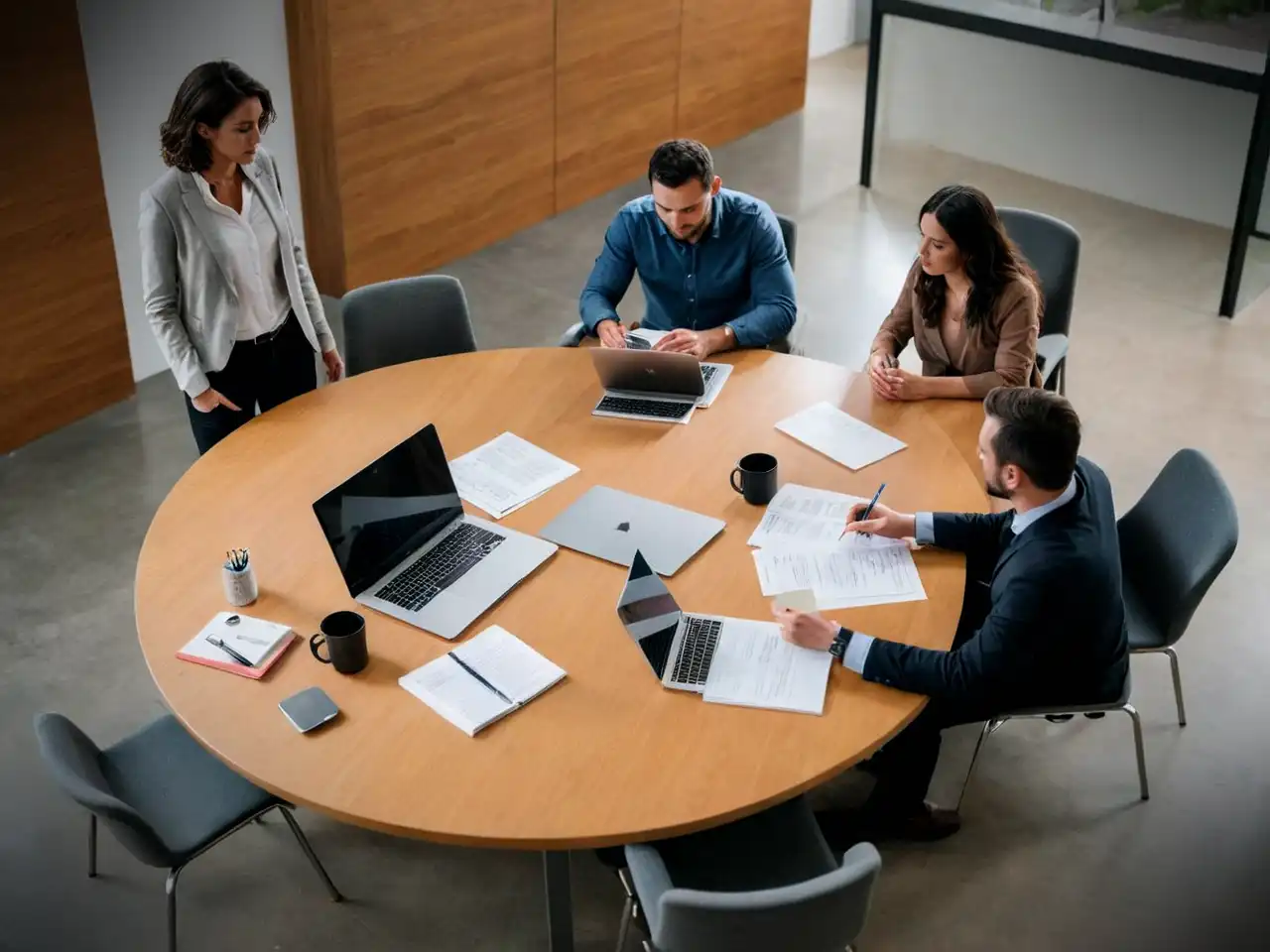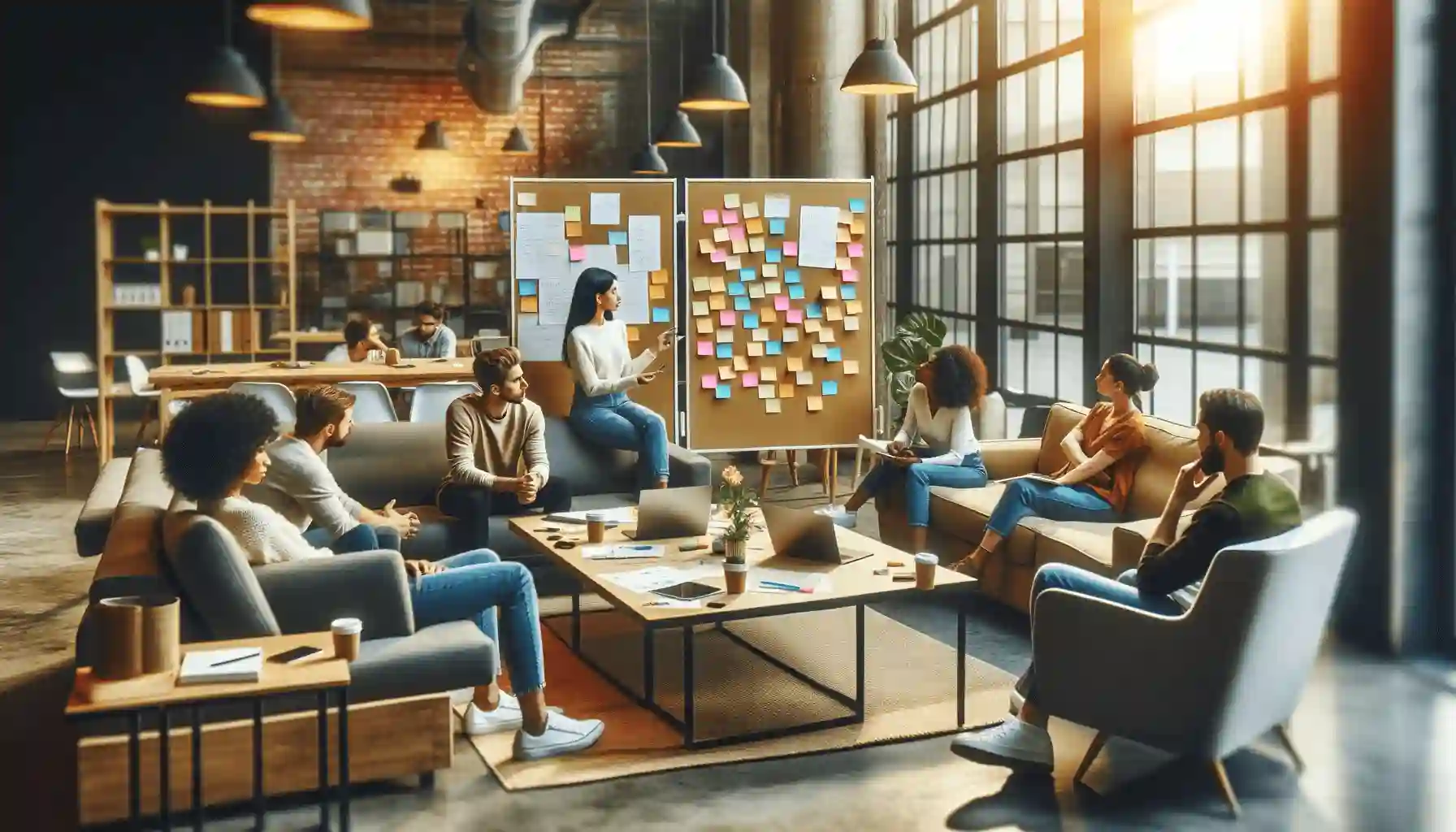Lunch Business Meeting
This guide will walk you through the essential elements of use lunch business meeting to keep your attendees aligned and engaged.
Try Lark for Free
Lunch business meetings are a unique and valuable way to conduct business discussions while enjoying a meal in a relaxed setting. These meetings offer an opportunity to build and nurture professional relationships, discuss important matters, and make important decisions. Whether you're meeting with clients, colleagues, or business partners, mastering the art of lunch business meetings can be a valuable skill. In this comprehensive guide, we'll explore the significance of lunch business meetings, how to conduct them effectively, and tips for making the most of these gatherings.
Use Lark Meetings to turn meetings into true collaborative experiences.
What is a lunch business meeting?
Understanding Lunch Business Meetings
A lunch business meeting is a meeting held over a meal, typically in a restaurant or a designated dining area. These meetings serve both a professional and social purpose, allowing individuals to combine work discussions with a more relaxed and social atmosphere.
Goals of a lunch business meeting
Building Relationships and Achieving Objectives
The primary goals of a lunch business meeting include:
- Relationship Building: Strengthening professional relationships with clients, colleagues, or partners.
- Discussion and Decision-Making: Engaging in meaningful discussions and making important decisions.
- Networking: Expanding professional networks and exploring potential opportunities.
- Information Exchange: Sharing information, updates, and insights related to business matters.
Who should attend a lunch business meeting?
Key Participants
Lunch business meetings can involve a range of key participants, including:
- Clients: Meeting with current or potential clients to discuss projects, proposals, or business opportunities.
- Colleagues: Gathering with colleagues or team members for work-related discussions and collaboration.
- Business Partners: Holding meetings with business partners to align strategies, discuss joint ventures, or make decisions.
Learn more about Lark x Meetings
Topics, agenda, and structure of a lunch business meeting
Structuring the Meeting
A lunch business meeting may have a flexible agenda but generally includes the following components:
- Introduction: Greeting and setting a friendly and professional tone for the meeting.
- Discussion: Engaging in business-related discussions, including project updates, proposals, or strategic planning.
- Decision-Making: If needed, making important decisions and outlining action items.
- Networking: Building rapport and expanding professional networks through casual conversation.
- Meal Selection: Ordering meals or refreshments while considering dietary preferences and restrictions.
- Conclusion: Wrapping up the meeting, expressing appreciation, and setting expectations for follow-up actions.
How to conduct an effective lunch business meeting?
Step-by-Step Guide
Conducting an effective lunch business meeting requires a combination of professionalism, social skills, and strategic planning. Follow these steps for a successful lunch business meeting:
- Preparation: Research the venue, menu options, and the preferences of your guests in advance.
- Timeliness: Arrive punctually to the meeting venue and reserve a table if necessary.
- Greeting: Extend a warm and professional greeting to your guests upon arrival.
- Ordering: Navigate the menu confidently, consider dietary restrictions, and initiate the ordering process.
- Balancing Conversation: Blend work-related discussions with friendly conversation to create a relaxed atmosphere.
- Engage Actively: Listen actively to your guests, ask open-ended questions, and encourage their participation.
- Decision-Making: If required, make decisions collaboratively and document action items.
- Networking: Expand your professional network by connecting with guests and exchanging contact information.
- Check Payment: Handle the bill payment smoothly, whether you choose to pay or split the bill.
- Follow-Up: Send thank-you notes and follow up on action items or next steps after the meeting.
Learn more about Lark x Meetings
How often should you hold lunch business meetings?
Meeting Frequency
The frequency of lunch business meetings varies based on the nature of your business and your goals. Some professionals may have these meetings occasionally, while others may incorporate them into their regular routine for relationship building and collaboration.
Key differences between lunch business meetings and similar meetings
Understanding Distinctions
Lunch business meetings have unique characteristics that distinguish them from other types of business gatherings:
- Informal Setting: They take place in a relaxed, non-office environment, such as a restaurant.
- Social Element: Lunch business meetings blend professional discussions with social interaction.
- Flexibility: The agenda and structure can be adjusted to suit the objectives and preferences of the participants.
Learn more about Lark x Meetings
Common pitfalls of lunch business meetings
Avoiding Mistakes
To ensure the success of lunch business meetings, be cautious of these common pitfalls:
- Overloading the Agenda: Trying to cover too many topics in a single meeting, leading to rushed discussions.
- Failing to Prepare: Not researching the venue or the preferences of your guests, resulting in awkward moments.
- Neglecting Dietary Restrictions: Choosing a restaurant without considering dietary restrictions of your guests.
- Monopolizing Conversations: Talking excessively about yourself or your agenda, leaving little room for others to participate.
Tips for maximizing the impact of lunch business meetings
Enhancing Effectiveness
To make the most of lunch business meetings, consider implementing these tips:
- Research and Preparation: Thoroughly research the venue and menu options to cater to your guests' preferences.
- Active Listening: Focus on actively listening to your guests and showing genuine interest in their perspectives.
- Balanced Discussion: Maintain a balance between business-related discussions and friendly conversation.
- Follow-Up: Send personalized thank-you notes and follow up on action items promptly.
Learn more about Lark x Meetings
Examples
Real-world scenarios
Real-world scenarios
Let's explore three real-world scenarios of successful lunch business meetings in various professional contexts:
Scenario 1: Client Relationship Building Meeting
Brief Content: A marketing executive arranges a lunch business meeting with a potential client to discuss a new marketing campaign. The meeting is held at a reputable restaurant.
*Detailed Content
*: The lunch business meeting begins with a warm greeting and an introduction to set a friendly tone. The marketing executive and the client review the proposed marketing campaign, including the strategy, target audience, and budget. They engage in an open and collaborative discussion, addressing the client's questions and concerns. Over a delightful meal, they finalize the campaign details, make decisions, and outline action items for both parties. The meeting concludes with a strong sense of partnership and excitement for the upcoming campaign.
Scenario 2: Team Collaboration Lunch Meeting
Brief Content: The members of a project team gather for a lunch business meeting to discuss project milestones and challenges. The meeting takes place at a nearby café.
Detailed Content: The team meeting kicks off with a friendly exchange of greetings and catching up on personal updates. They review the project's progress, milestones achieved, and any roadblocks encountered. During the discussion, team members openly share their insights and brainstorm solutions to address challenges. Over sandwiches and salads, they collaboratively set priorities, allocate tasks, and establish deadlines for upcoming project phases. The meeting wraps up with a sense of unity and renewed enthusiasm to tackle project challenges together.
Scenario 3: Partnership Negotiation Lunch Meeting
Brief Content: Two business executives meet over lunch to negotiate the terms of a potential partnership between their companies. The meeting is held at an upscale restaurant.
Detailed Content: The lunch business meeting begins with a cordial greeting and a discussion of their shared objectives and potential synergies. The executives delve into detailed negotiations, covering topics such as revenue sharing, contractual obligations, and intellectual property rights. While navigating complex discussions, they also engage in lighter conversation to build rapport and trust. Over a gourmet meal, they reach mutually beneficial agreements, confirm action items, and plan the next steps in the partnership. The meeting concludes with a sense of accomplishment and excitement for the future collaboration.
Tips for do's and don'ts
Best Practices and Pitfalls to Avoid
Follow these do's and don'ts to ensure productive and effective lunch business meetings:
| Do's | Don'ts |
|---|---|
| Research the venue and menu options in advance of the meeting. | Don't choose a restaurant without considering the dietary preferences or restrictions of your guests. |
| Maintain a balance between professional discussions and friendly conversation during the meeting. | Avoid monopolizing the conversation or diverting discussions away from the intended agenda. |
| Actively listen to your guests and show genuine interest in their perspectives and opinions. | Don't overload the meeting agenda with too many topics, leading to rushed discussions. |
| Follow up promptly after the meeting with personalized thank-you notes and action item updates. | Neglect to send thank-you notes or follow up on agreed-upon action items and next steps. |
Use Lark Meetings to turn meetings into true collaborative experiences.
A Game Changer for Lunch Business Meeting: Empower your team with Lark Meetings
In the fast-paced and dynamic world of modern business, effective communication and collaboration are crucial for success of Lunch Business Meeting. Here we introduce Lark Meetings to serve as a centralized hub for all communication needs.
Transform your meetings into collaborative endeavors
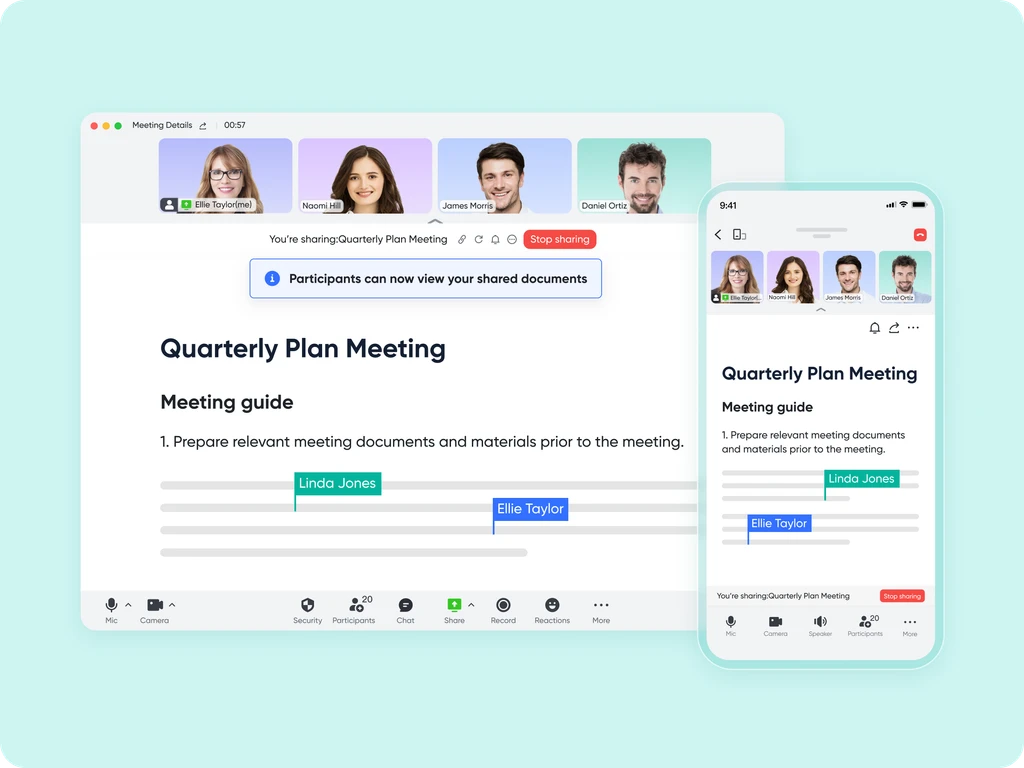
Leverage the potency of in-call document sharing, intelligent meeting minutes, and mobile-optimized features to enhance productivity collaboratively, irrespective of your location or schedule.
Seamlessly collaborate in real-time, across any device
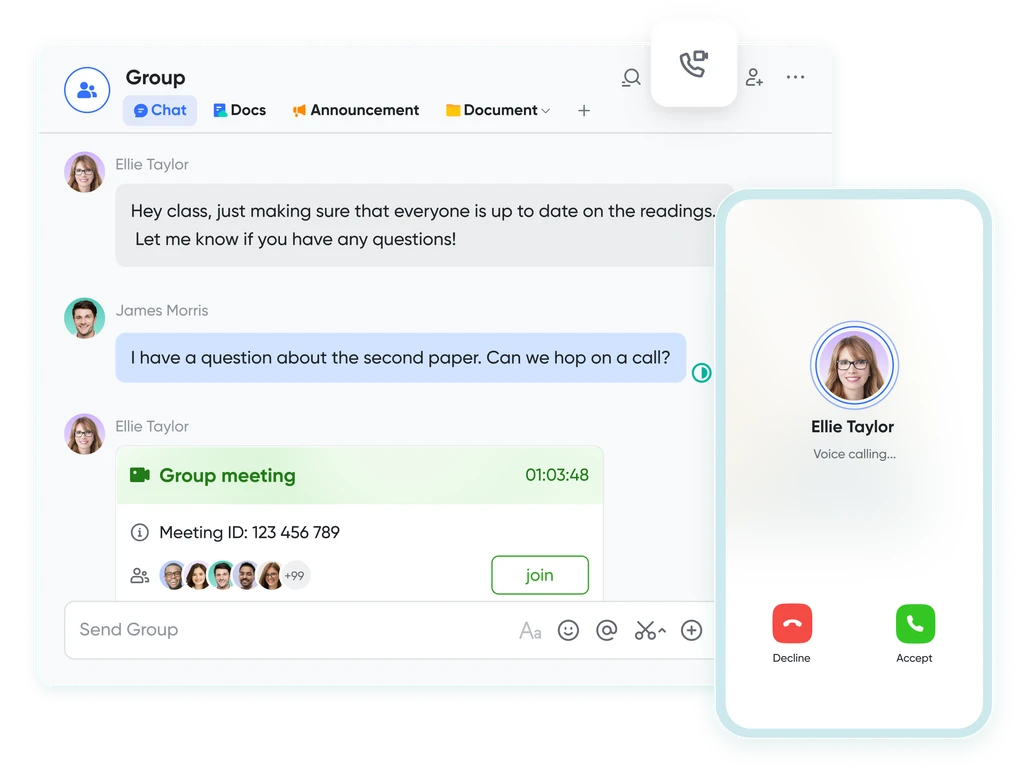
Share live documents instead of just screen views. Participants can navigate and edit simultaneously within the video call window, even while on the move.
Shift your focus to engagement, not note-taking
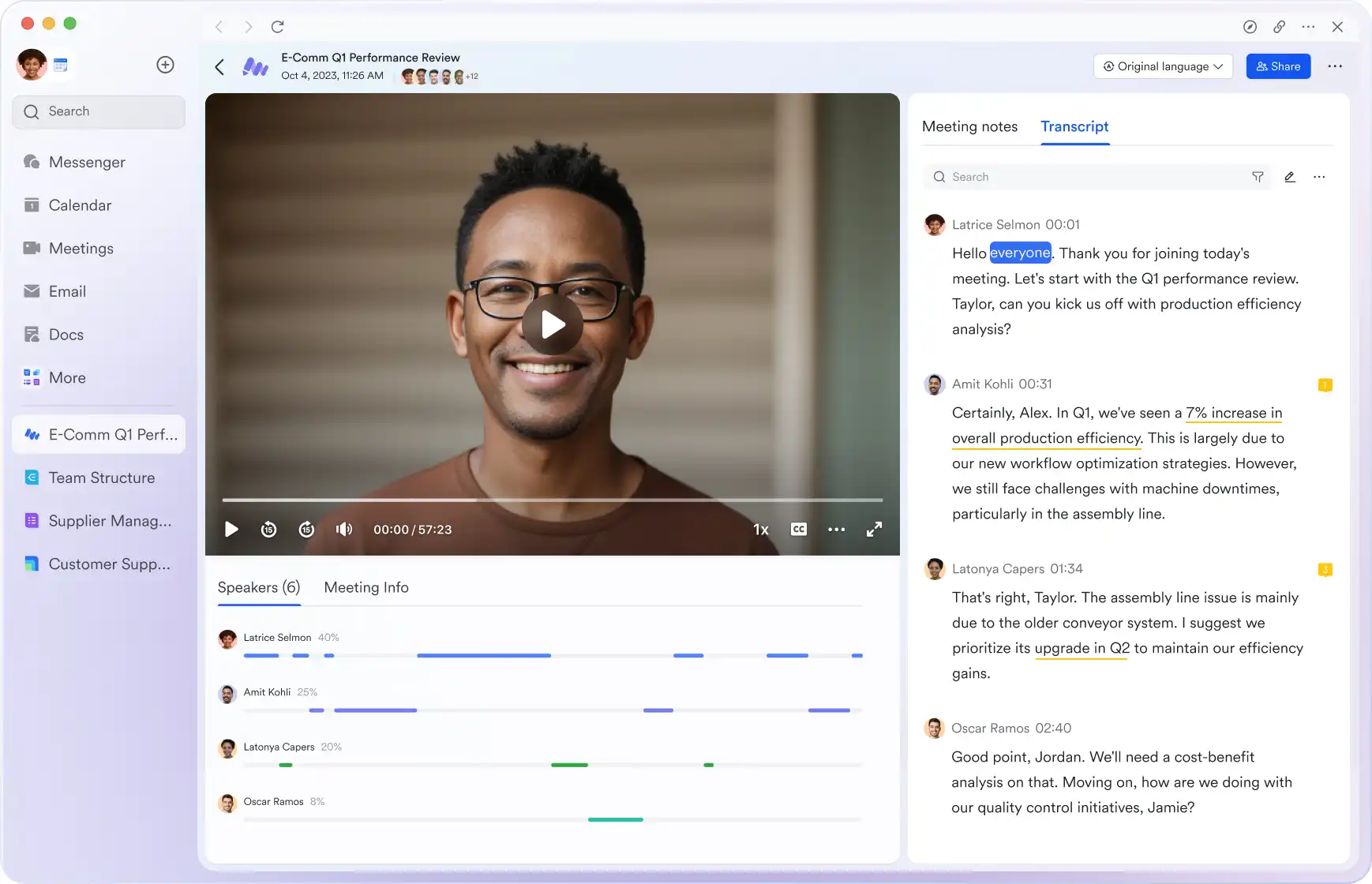
Lark Minutes automatically converts video meetings into transcripts, facilitating easy viewing, searching, and collaborative editing. Stay in the loop asynchronously, even if you can't attend the live meeting. Lark Minutes for meeting minutes support translation into 10+ different languages.
Break language barriers in communication
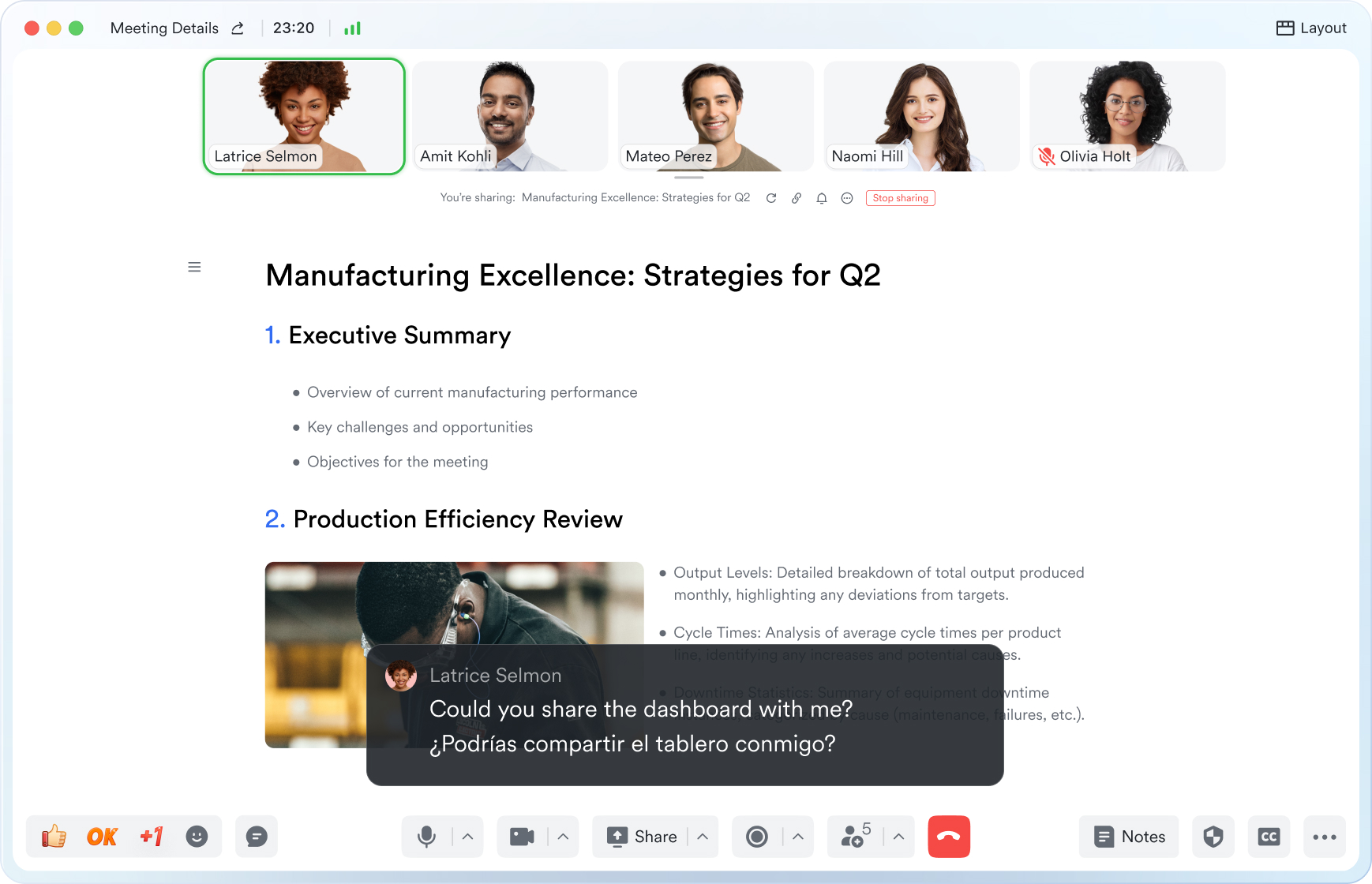
Lark Meetings provide real-time translation for subtitles, allowing individuals from diverse backgrounds to express themselves in their native languages. Ensure every voice is heard, regardless of geographical location. Live subtitles currently support translations from English, Chinese, and Japanese to 10+ different languages. See more translation feature in Lark.
Connect with larger audiences
Host dynamic online meetings and events accommodating up to 1,000 participants, with the flexibility of up to 50 breakout sessions for intimate group discussions within the larger meeting context. Try more Lark features for free.




